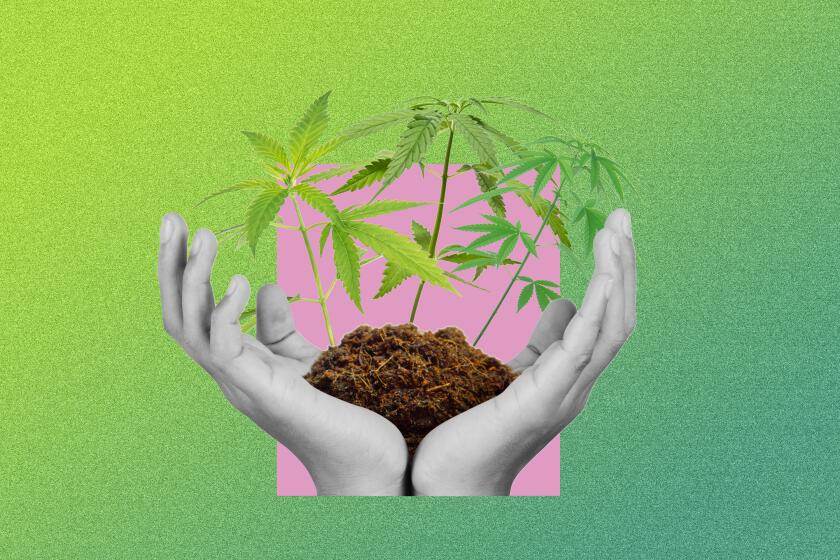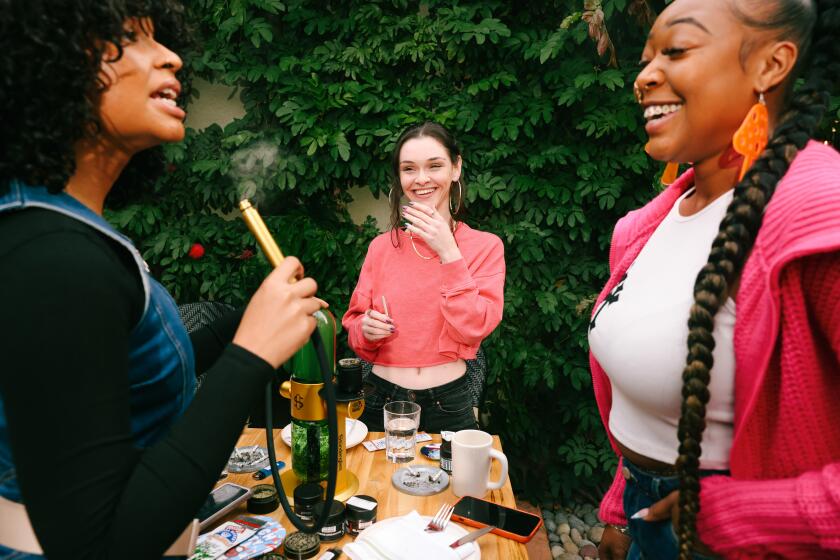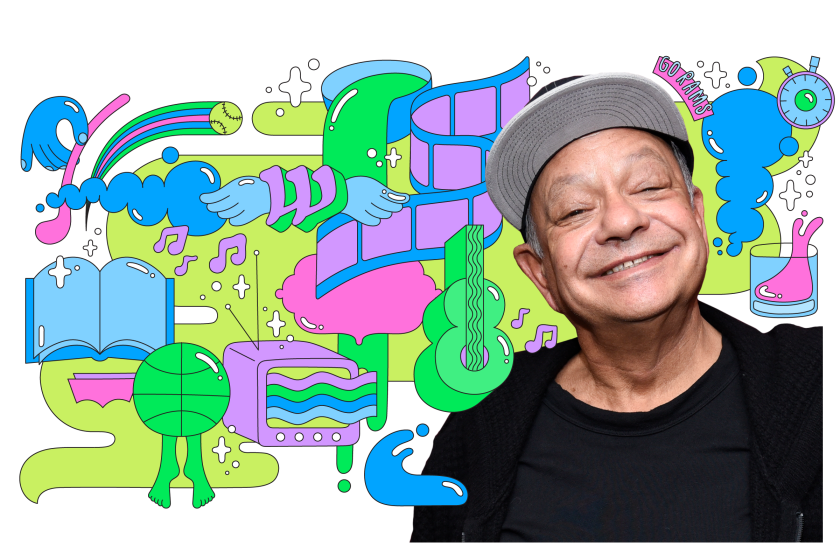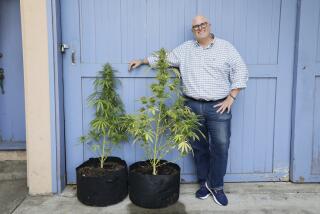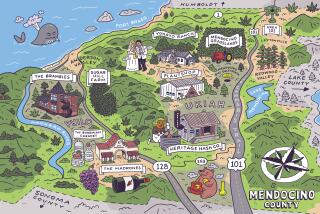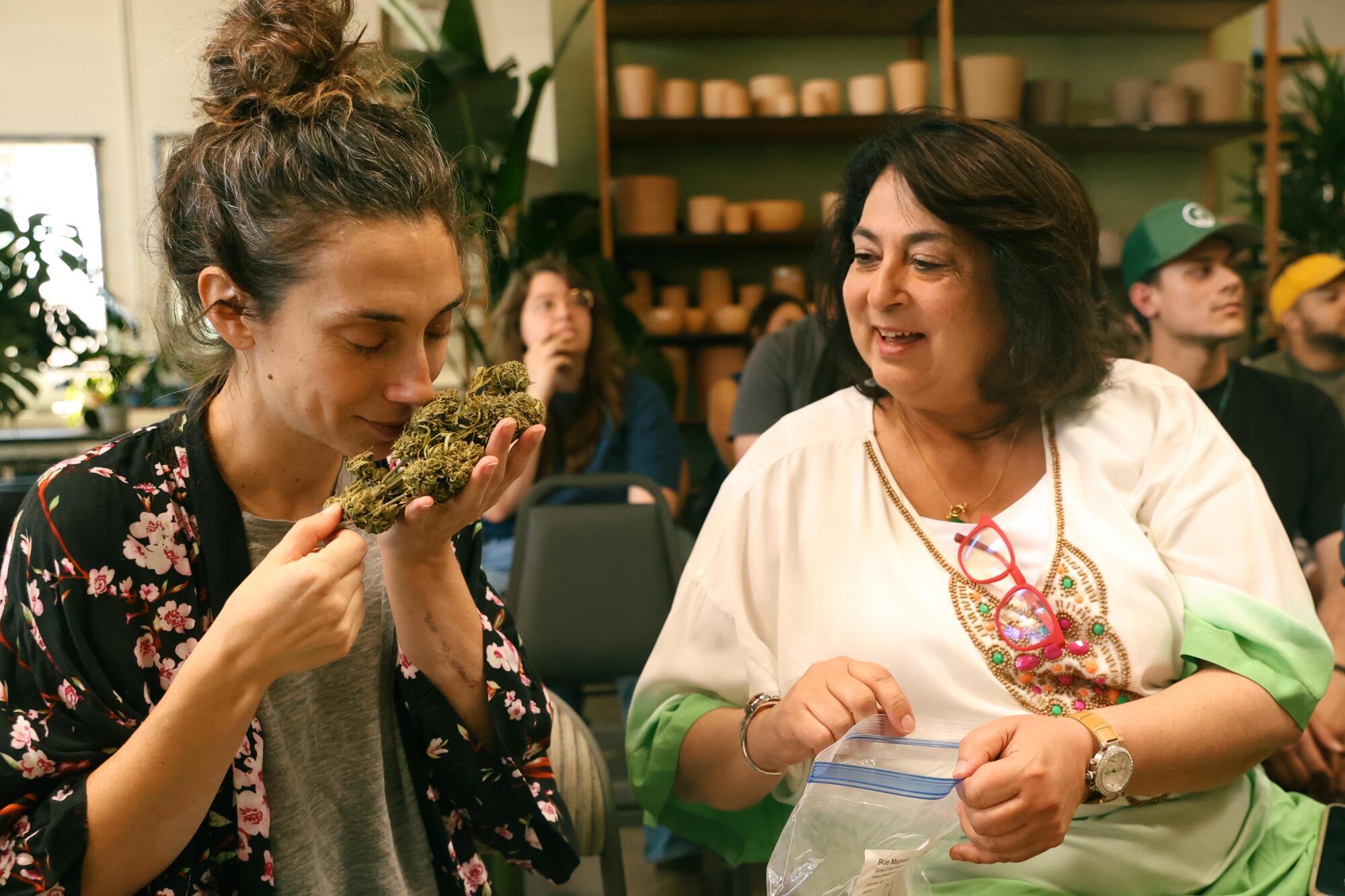
- Share via
If you’ve ever considered growing your own pot plant at home in Southern California but found the whole tents-and-timers-in-a-closet thing impossibly confusing or prohibitively intimidating (or both), the good news is that it doesn’t have to be either. That’s the takeaway from a series of workshops that have taken place at nurseries and gardening centers across L.A.
Motivated by a desire to demystify and destigmatize growing hemp and cannabis at home (and funded in part by a USDA grant), Emily Gogol (head gardener of Oregon-based Grow It From Home) and Penny Barthel (author of “The Cannabis Gardener” and Bay Area co-founder of the educational website Wondering About Weed) have been helping aspiring ganja greenthumbs across the Southland get their grow on since earlier this year. Their basic premise? A cannabis plant is as easy to grow — in your backyard garden or on your patio — as a tomato plant.

That was one of the surprising things I walked away with after catching one of the duo’s hourlong free workshops at C&S Garden Center in Lawndale one late April Saturday afternoon. There, surrounded by bags of fertilizer, shelves full of planters and every kind of leafy green plant imaginable, Gogol and Barthel offered pointers and answered questions for a group of 30 hobby gardeners who had come seeking guidance before growing their first pot plant in the natural SoCal sunlight.
Having experienced the whole lights-and-timers thing firsthand when I grew my first plant a few years back, I was intrigued by the garden-club feel of the duo’s approach as well as their efforts to move cannabis gardening from the exclusive, insular realm of basements and bro culture and put it in its rightful place: on the patio right next to the trellised tomatoes and cooking herbs. (As Gogol pointed out early in the workshop I attended, the whole reason most cannabis plants grown at home were traditionally indoors and out of sight was because of a half-century of pot prohibition.)
Taking cannabis from seed to sesh connected me to the plant in ways I hadn’t expected.
Even before I caught their late April workshop, I’d considered adding a plant to the greenery of my L.A. backyard. But something Gogol told the workshop attendees really sealed the deal for me: “You guys actually live in one of the best places on the planet to grow cannabis,” she said.
Once I heard that, I felt compelled (for journalistic purposes, if nothing else) to see just how easy it could be. Especially because, as I was soon to learn, I had not missed this season’s outdoor planting window. And as of this publication, neither have you, so if you’re a backyard gardener thinking about adding a pot plant to your plot or a weed head contemplating an adventure in hazy horticulture, here are five things that will help you successfully (and legally) get growing.
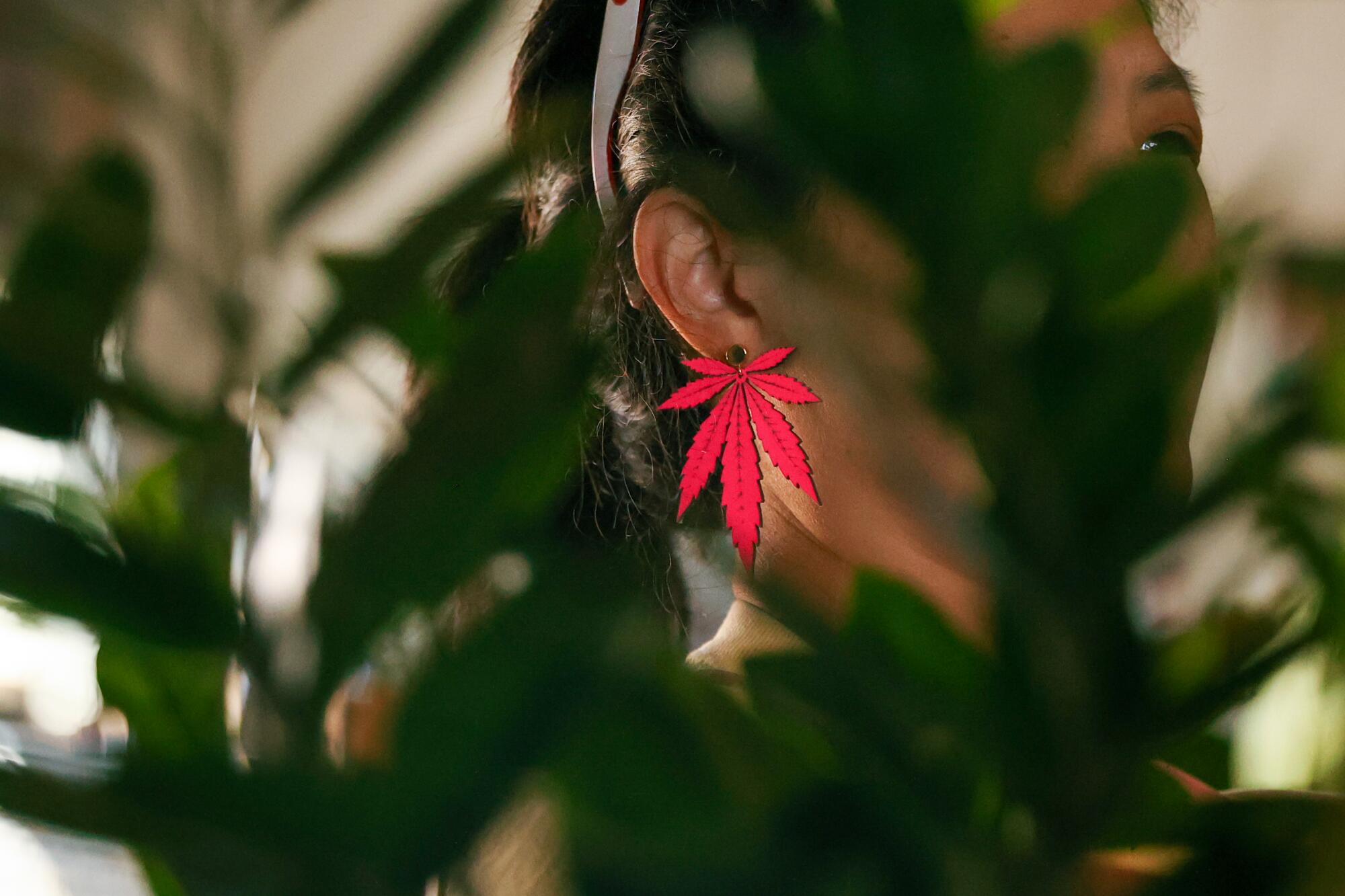
1. Know what’s legal where you live
Although it may be as easy to grow as tomatoes or zucchini, growing cannabis is different in one very important way: Under state law, you have to be age 21 (different regulations apply to medical marijuana patients), you’re limited to growing six plants per private residence and, most important, if you’re growing outdoors (that’s why you’re here, right?), the plants must be in a locked space that is not visible to the public. (In other words, the front yard is no-go; a fenced-in backyard or enclosed patio is a better bet.)
What you’ll need to know beyond that to keep your home grow legal depends on where in California you live because cities and counties can further restrict (or outright ban) personal-use cultivation. The cities of Los Angeles and West Hollywood don’t have additional regulations, while L.A. County’s ordinance (which applies to unincorporated areas of the county) has all kinds of specifics to keep in mind. These include a minimum distance from rear and side property lines (10 feet), maximum plant height (6 feet) and type of fencing (masonry or wood is OK; chain link is not).
If your eyes are starting to glaze over — and not in a good way — check out the county’s very helpful handout on the topic. For L.A. County residents, a good starting point to find out local laws is the database of rules and regulations compiled by the Los Angeles chapter of NORML (the National Organization for the Reform of Marijuana Laws) at lanorml.org.
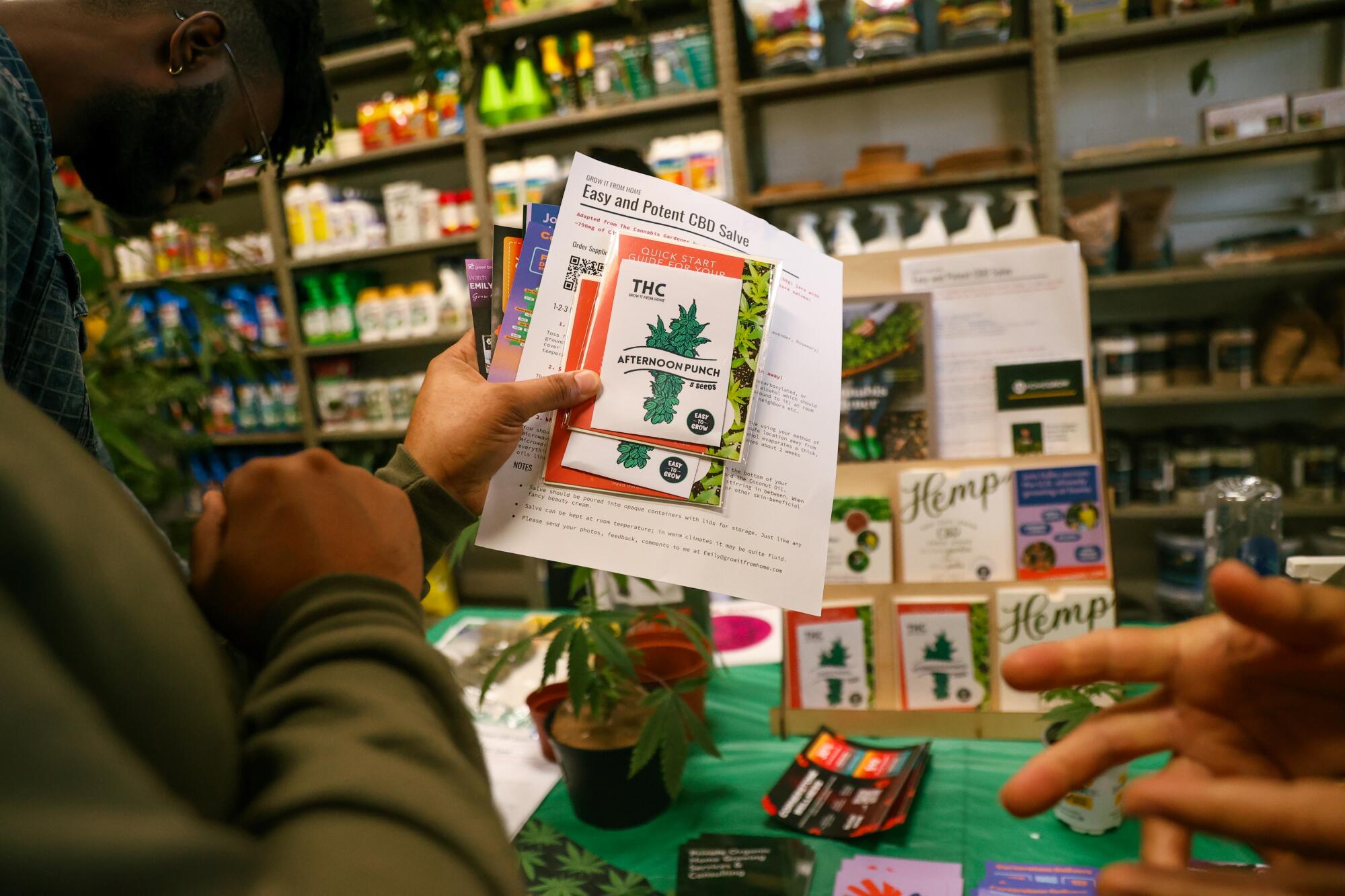
2. Get the right seeds
“One of the differences from tomato [plants] that makes cannabis so special and fun — but also confusing — is that cannabis plants can be male or female,” Gogol said during the C&S workshop I attended. “And basically, when you grow cannabis for flower, you want them to be the female plants, so we’d encourage you to purchase female seeds — they’re called ‘feminized’ seeds.”
Another seed term to be on the lookout for, especially if you want to make the most of the SoCal sunlight, is “photoperiod,” which means the resulting plant will start to flower (i.e., start producing those tasty buds) when the amount of light drops below 12 hours each day. (There are also autoflower seeds whose resulting plants begin to flower after a set period of time regardless of the amount of light they receive.) Beyond that, what kind of seeds you buy depends a lot on what end product you’re hoping to harvest as well as what you can find.
What do you do if you’re annoyed by neighbors smoking weed? How do you find clean wax? What are my first steps in using cannabis to combat appetite loss from chemotherapy? Why doesn’t L.A. have more weed lounges?
This brings me to what might be the coolest thing (of many cool things) I took away literally and figuratively from the C&S workshop: an old-timey-looking seed packet no different from what you’d find at any garden center. Except, that is, for the bold letters THC in the upper left-hand corner of the front, an artfully drawn leafy green pot plant and the words “Afternoon Punch” (a cultivar described on the back with the words sweet, raspberry and hibiscus).
Inside the $45 packet were five feminized, photoperiod seeds from Gogol’s Oregon farm, and they can be purchased with no more hassle — or stigma — than anything else at C&S Garden Center. (Grow It From Home’s seeds also are available locally through Fig Earth Supply, Flora Grubb Gardens L.A. and International Garden Center as well as the C&S Nursery in the Baldwin Hills/Crenshaw neighborhood.)
While that may not seem like a big deal — especially in a place like Los Angeles, where seeds (and seedlings) have long been available in dispensaries (or surreptitiously via mail, arriving in unmarked packages) — Gogol and Barthel see being able to pick up cannabis seeds in the same place as any other gardening supplies as a game-changer when it comes to making patio pot growing more accessible to the kind of casual gardeners who would feel much more at ease in a nursery than a dispensary.
It’s also something that’s relatively new and uncharted territory, Gogol said, explaining that she is relying on a 2022 Drug Enforcement Administration letter (known as the Pennington letter) that clarified that cannabis seeds containing less than 0.03% THC (which they do) are legally classified as hemp and exempt from the Controlled Substances Act. “It’s legal,” Gogol said about making seeds available this way. “I’ve got a whole binder on [the topic].”
In an interview with The Times, Shane Pennington, the lawyer whose inquiry resulted in the DEA’s clarification, confirmed Gogol’s interpretation but added a note of caution. “Just because it’s not illegal under the federal Controlled Substances Act doesn’t mean that it’s legal for all purposes, under every other law in the United States or in every state or every jurisdiction in every state,” he said.

3. Seek out the sun
Assuming you’re keeping legal requirements in mind, where’s the best outdoor place for your plant? “Where you get your sun is where you should grow your cannabis,” Barthel told attendees. “Even if it’s not in the ground.”
Gogol concurred, adding that “it’s better to grow in a container with full sun — eight to 12 hours a day — than in the ground in a shade situation.”
If you’re going the container route, Gogol suggested using one in the 10- to 15-gallon range (“terracotta, plastic, fabric — it doesn’t matter”) and to use a high-quality potting soil. “Something like [Fox Farm’s] Ocean Forest. It doesn’t say ‘cannabis’ on it. It doesn’t say ‘dank’ anything,” she said. “It’s what you would buy if you were going to grow a couple of tomatoes and maybe a miniature eggplant on a trellis on your patio.” (Another option, suggested in “The Cannabis Gardener,” Barthel’s book for beginners, is EB Stone’s Recipe 420 Potting Soil.)
Whether you’re growing in the ground or using a container, Barthel said, “You can’t go wrong by using compost.”
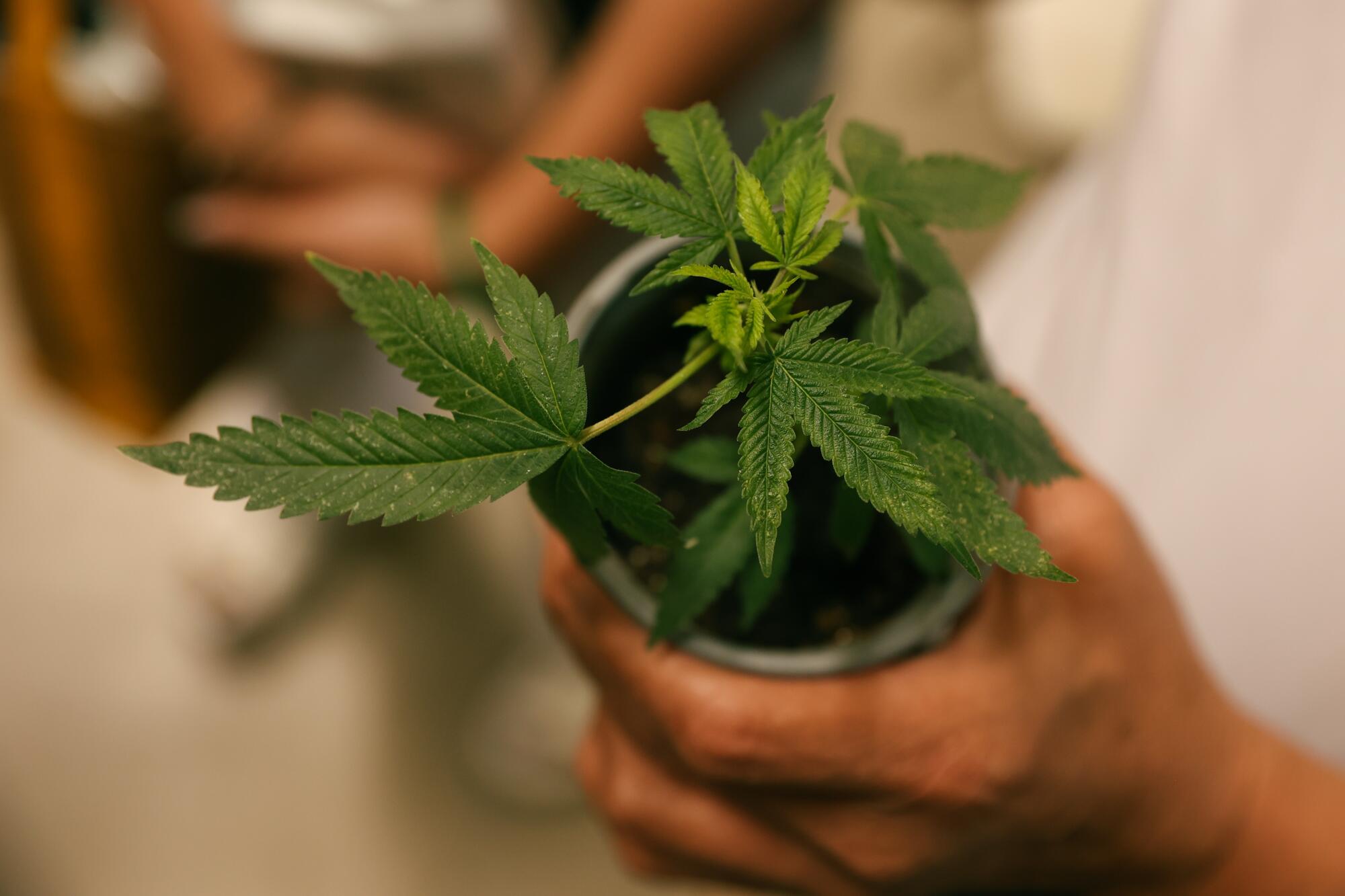
4. Plant between 4/20 and Father’s Day
“When to start your seeds or get your [seedlings] is about controlling the size of the plant,” Gogol told workshop attendees. “So if you want a 5-foot-tall, human-size plant that’s going to yield bags and bags of flower — and be easy to harvest and take care of and manage and give you almost no trouble — we tell folks to start anytime after 4/20 and before Father’s Day. It’s really a window.”
In the nearly four years since Southern California’s first ganja gastropub shuttered, the consumption lounge scene has changed dramatically.
Always the third Sunday in June, Father’s Day falls on June 16 this year, so this year’s window is only open for a few more weeks.
This was another one of the many things from the workshop that surprised me because I’d previously read — and taken as gospel — that seeds needed to be planted no later than Mother’s Day.

5. Don’t overwater
Gogol and Barthel said the No. 1 mistake budding gardeners make is overwatering their plant babies. “You want to water [your plants] as deeply and as infrequently as possible,” Gogol said. “If you’re growing in a container, put your hand in the soil and dig around. If it feels bone dry all the way down to finger length, then give it water. And if you’re watering in a container, you’ll want to water fully so the water flushes out the bottom of the pot for a little bit. In [Southern California] where it doesn’t get that hot, you can honestly water deeply once a week or maybe twice a week if you’re having a hot dry spell. But you want to err on the side of under-watering. It does not want wet feet — it’s not a hydrangea. Again, think of it like a tomato.”
Is growing weed in your garden — or on your patio — any more complicated than that? Gogol and Barthel assured us it’s not. Even so, I’ve barely scratched the surface of what both pot professionals covered in that hour-long workshop, so if you’re feeling canna-curious and want to pepper a pro with questions before the get-’em-in-the-ground window closes, you’ve got a handful of options. One is a June 3 online workshop (prices start at $5) or a handful of in-person workshops in the L.A. area in the run-up to Father’s Day and one on the day itself (the latter will include giveaway Father’s Day bouquets that incorporate cannabis foliage).
Bowls of soup, bowls of herb, stacks of newspapers and a salon of sorts with wife Natasha add up to the perfect Sunday for the comedian, actor and prolific art collector.
Additional information and free tickets are available at growitfromhome.com. (There are also four workshops scheduled for the Bay Area before the planting window closes.) Otherwise, these five pointers should at least get you started down the ganja garden path legally and logistically.
And who knows, if it really is as easy as growing tomatoes, in the fall I (and perhaps some of you) may be signing up for another one of their workshops — the one where they teach how to properly harvest all that backyard bounty.
More to Read
Sign up for The Wild
We’ll help you find the best places to hike, bike and run, as well as the perfect silent spots for meditation and yoga.
You may occasionally receive promotional content from the Los Angeles Times.

